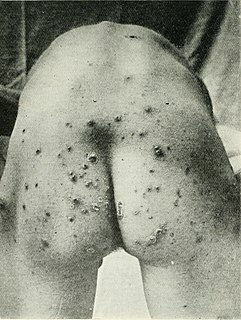| Blastomycosis-like pyoderma | |
|---|---|
| Other names | Pyoderma vegetans [1] |
| Specialty | Dermatology |
Blastomycosis-like pyoderma is a cutaneous condition characterized by large verrucous plaques with elevated borders and multiple pustules. [2] :255,272
| Blastomycosis-like pyoderma | |
|---|---|
| Other names | Pyoderma vegetans [1] |
| Specialty | Dermatology |
Blastomycosis-like pyoderma is a cutaneous condition characterized by large verrucous plaques with elevated borders and multiple pustules. [2] :255,272

Tuberculosis verrucosa cutis is a rash of small, red papular nodules in the skin that may appear 2–4 weeks after inoculation by Mycobacterium tuberculosis in a previously infected and immunocompetent individual.

Pyoderma gangrenosum is a rare, inflammatory skin disease where painful pustules or nodules become ulcers that progressively grow. Pyoderma gangrenosum is not infectious.

The Koebner phenomenon or Köbner phenomenon, also called the Koebner response or the isomorphic response, attributed to Heinrich Köbner, is the appearance of skin lesions on lines of trauma. The Koebner phenomenon may result from either a linear exposure or irritation. Conditions demonstrating linear lesions after a linear exposure to a causative agent include: molluscum contagiosum, warts and toxicodendron dermatitis. Warts and molluscum contagiosum lesions can be spread in linear patterns by self-scratching ("auto-inoculation"). Toxicodendron dermatitis lesions are often linear from brushing up against the plant. Causes of the Koebner phenomenon that are secondary to scratching rather than an infective or chemical cause include vitiligo, psoriasis, lichen planus, lichen nitidus, pityriasis rubra pilaris, and keratosis follicularis.

Hyper IgM Syndrome Type 1 (HIGM-1) is the X-linked variant of the hyper IgM syndrome.

Grover's disease (GD) is a polymorphic, pruritic, papulovesicular dermatosis characterized histologically by acantholysis with or without dyskeratosis. Once confirmed, most cases of Grover's disease last six to twelve months, which is why it was originally called "transient". However it may last much longer. Nevertheless, it is not to be confused with relapsing linear acantholytic dermatosis.

Pyoderma means any skin disease that is pyogenic. These include superficial bacterial infections such as impetigo, impetigo contagiosa, ecthyma, folliculitis, Bockhart's impetigo, furuncle, carbuncle, tropical ulcer, etc. Autoimmune conditions include pyoderma gangrenosum. Pyoderma affects more than 111 million children worldwide, making it one of the three most common skin disorders in children along with scabies and tinea.
Pathergy is a skin condition in which a minor trauma such as a bump or bruise leads to the development of skin lesions or ulcers that may be resistant to healing. Pathergy can also lead to ulcerations at the site of surgical incisions. Pathergy is seen with both Behçet's disease and pyoderma gangrenosum. A highly similar phenomenon known as the Koebner phenomenon occurs in autoimmune diseases such as psoriasis and systemic lupus erythematosus, among others.
Erythema gyratum repens is a figurate erythema that is rapidly moving and usually a marker of underlying cancer, usually from the lung.
Tuberculosis cutis orificialis is a form of cutaneous tuberculosis that occurs at the mucocutaneous borders of the nose, mouth, anus, urinary meatus, and vagina, and on the mucous membrane of the mouth or tongue.
Parakeratosis pustulosa is a cutaneous condition which is exclusively seen in children, usually involving one finger, most commonly the thumb or index finger, with the affected nail showing subungual hyperkeratosis and onycholysis.
Paraneoplastic acrokeratosis, or Bazex syndrome is a cutaneous condition characterized by psoriasiform changes of hands, feet, ears, and nose, with involvement of the nails and periungual tissues being characteristic and indistinguishable from psoriatic nails. The condition is associated with carcinomas of the upper aerodigestive tract.

Koenen's tumor is a cutaneous condition that results in fifty percent of tuberous sclerosis cases. It can also be subungual.
Cutaneous actinomycosis is a chronic disease that affects the deep subcutaneous tissue of the skin. Caused by an anaerobic, Gram-positive, filamentous type of bacteria in the genus Actinomyces, invasion of the soft tissue leads to the formation of abnormal channels leading to the skin surface that discharge pale yellow sulfur granules.

Cutaneous lymphoid hyperplasia refers to a groups of benign cutaneous disorders characterized by collections of lymphocytes, macrophages, and dendritic cells in the skin. Conditions included in this groups are:
Perianal cellulitis is a cutaneous condition that presents as sharply demarcated, bright, perianal erythema extending 2–3 cm around the anal verge.
Superficial granulomatous pyoderma is a cutaneous condition, a variant of pyoderma gangrenosum characterized by a localized superficial vegetative or ulcerative lesion, which usually follows trauma, such as surgery.
Granuloma gluteale infantum is a cutaneous condition that appears in the anogenital region of infants as a complication of diaper dermatitis.
Pseudomonal pyoderma is a cutaneous condition, a superficial infection of the skin with P. aeruginosa. The skin can have a 'mousy' odor. It presents typically on the feet with macerated 'moth-eaten' appearance, green-blue purulence, and eroded borders.
Pseudomonas hot-foot syndrome is a self-limited cutaneous condition that occurs on the plantar surface of children after swimming in pool water that has high concentrations of P. aeruginosa. The condition typically presents as plantar purple-red nodules.
| Classification | |
|---|---|
| External resources |